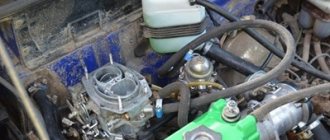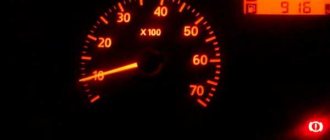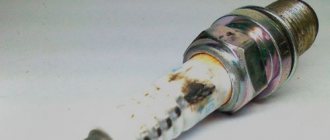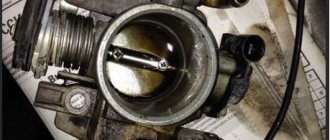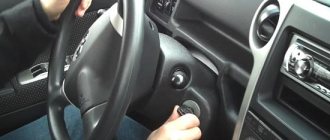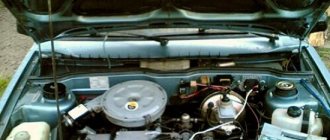The failure of the power unit to operate when cold or after warming up to a certain temperature may indicate a fairly wide list of possible problems. The engine begins to stall both suddenly and to work unstably in different modes, after which the internal combustion engine stops.
We also recommend reading the article about why the engine does not develop full power. From this article you will learn about the causes and ways to solve this problem.
In this article we will talk about the reasons why the engine stops at idle, as a result of which a warm engine stalls, why a car with a hot engine stalls while driving, etc.
What happens to the engine and fuel system when heated
To determine the reasons why a car stalls when hot, it is necessary to consider the processes that occur in the power unit and fuel system during heating. While the engine is cold:
- thermal clearances between valves and camshaft and piston ring locks are maximum;
- the oil is very viscous, so the thickness of the lubricant layer on the rubbing parts, as well as their protection, is minimal;
- the temperature inside the combustion chamber is equal to the outside temperature, which is why the fuel ignites more slowly from a standard spark.
Therefore, starting a car engine occurs in extremely unfavorable conditions, and warming up is necessary to reach normal operation.
After starting the engine, the air-fuel mixture burns in the cylinders, releasing a small part of the heat to the engine and cylinder head (cylinder head). The coolant that washes the block and cylinder head evenly distributes the temperature throughout the engine, thereby eliminating temperature deformations.
As it warms up:
- thermal clearances are reduced, which leads to increased compression and increased engine efficiency;
- the oil dilutes, providing effective lubrication of rubbing surfaces;
- the temperature inside the combustion chamber increases, due to which the air-fuel mixture flares up faster and burns more efficiently.
These processes occur inside automobile engines of any type. If the power unit is working properly, then no problems arise, but if the car heats up and stalls, then the reason for this is always a malfunction of the engine or fuel equipment.
This may end up postponing the problem until “later.”
If the problem is not corrected immediately, then after some time it will become much more serious and it will be necessary to carry out not minor, but major engine repairs.
Carburetor repair by specialists is the best solution
If you have a carbureted car, it would be best to find a professional who can service the equipment regularly. Your car will require high-quality maintenance on a regular basis, since the carburetor is constantly becoming clogged and presents more and more problems in operation. Therefore, it would be best to use the services of a specialist who knows his business very well and performs cleaning, regular maintenance and repair of carburetors, as well as all related equipment. The main criteria for choosing a specialist are as follows:
- experience in working with your car model, sufficient professionalism, confirmed by years of work;
- positive reviews from other owners of carburetor cars who received quality service;
- affordable prices - you don’t have to choose an expensive service station, you can cooperate with a private master;
- fairly quick completion of all necessary repair work, but the presence of a guarantee of the quality of the result;
- the possibility of ordering complex work with the purchase of spare parts performed by a specialist in order to relieve oneself of responsibility for the quality of parts;
- other convenient services, as well as the possibility of full vehicle maintenance.
It is convenient when all repairs and maintenance are carried out by one person. This makes it quite easy to get a high-quality working car, since one person or one company is responsible for it. If one person repairs your carburetor, another person maintains the car, and a third person solves problems with the generator, all this is not very convenient for repair work on the car. So it’s better to find a universal specialist and constantly service the car exclusively from him. If you have a Solex carburetor installed on your car, we suggest watching a video about its disassembly and maintenance:
Reasons why a car stalls when hot
If the car heats up and stalls, then the reasons should always be sought in the technical condition of the engine and its components, and often the defect can be in several connected or even unrelated systems. Next, we will talk about all the most common reasons why a car stalls when hot, and all other faults are a combination of them.
Cooling system malfunctions
Cooling system malfunctions are:
- broken pump belt (if it is not connected to the timing belt);
- low coolant level;
- a thick layer of scale on the walls of the channels (appears due to mixing different types of antifreeze);
- damage to the pump blades;
- pump bearing jamming;
- dirty radiator;
- crushed pipes and pipes;
- The temperature sensor is faulty.
The first sign that when the engine heats up the car stalls due to a malfunction of the cooling system is a low level of antifreeze (experienced drivers check its amount at least once a week).
This is due to the fact that ineffective engine cooling causes local overheating of individual sections of the power unit (most often the cylinder head) and boiling of antifreeze in them. And since the basis of any antifreeze is water, when it boils it turns into steam and escapes into the atmosphere through the valve in the expansion tank cap, which leads to a decrease in the level.
Replacing valve stem seals
Remember: even if the engine boils only once or quickly heats up to dangerous levels, but does not boil, then it already needs to be opened and diagnostic repairs carried out. It is much easier to replace oil seals that have dried out from high temperatures than to carry out major repairs after a few months.
Fuel boiling in the ramp or carburetor
If the car warms up and stalls, and does not start, then the malfunction is caused by improper operation of the cooling system (poor coolant circulation or dirty radiator), while the temperature indicator needle is near the red zone, but does not cross it.
The main symptom is the inability to start the engine after stopping for several minutes, while it may “sneeze”, or, as drivers say, seize, that is, fuel enters the cylinders, but its quantity is not enough.
Then the temperature in the ramp or carburetor decreases and the engine can be started again, but it will not work for long under load. If the indicator shows a temperature below the red zone, then the sensor needs to be replaced. There are cases when the car starts up hot and stalls immediately or after a few seconds; these are also caused by overheating of the fuel in the ramp or carburetor. After the temperature drops, such an engine starts normally, which confirms this reason.
Incorrect air/fuel mixture ratio
The reasons for this malfunction are:
- air leak;
- Fuel level in the float chamber is too high;
- leaking or stuck injectors.
Diagnostics of a car for air leaks
If a carburetor engine starts easily when cold even without pulling the choke handle, and then the car heats up and stalls, then the reason for this is that the fuel level in the float chamber is too high or the air jet is dirty. Excess fuel allows the engine to start easily when cold, but once warmed up, a leaner mixture is required, and the carburetor cannot do it. For the same reason, on a carburetor car, a warmed-up power unit stalls when you press the gas pedal, but while the engine is cold, this does not happen even without suction.
If a carburetor car stalls when hot at idle, that is, at low speeds, but pulling out the choke handle corrects the situation, then the cause is air leaks, which we talked about in detail here (Why does a car stall at idle - the main reasons and malfunctions).
If the carburetor does not have a choke handle (this function is automated in it), and the car stalls when hot and does not start until it cools down, then you cannot do without removing and disassembling this part. Clean jets and the correct fuel level indicate overheating of this part (read the previous section).
Ramps and injectors often become one of the reasons leading to engine stopping
On injection power units, this behavior is most often caused by retraction or loose closing of the injector needle, which causes too much fuel to enter the chamber. A mixture with such proportions does not ignite well and also burns for a long time, which leads to ineffective conversion of gasoline or diesel fuel into kinetic energy, which causes the engine to stop.
Loss of contact due to thermal expansion
This malfunction most often occurs where the driver has to drive on roads that are dirty or treated with an anti-icing agent based on table salt.
High levels of humidity and aggressive substances lead to oxidation of the terminals of contact connections, and thermal expansion caused by heating disrupts the electrical conductivity of the contact pair.
In terms of external manifestations, this problem is similar to boiling fuel, and the only diagnostic method is a complete check of all contacts.
Incorrect valve adjustment
If the thermal gap between the valves and the camshaft(s) is less than necessary, that is, they are clamped, then after the engine warms up, such valves no longer close completely, which reduces compression and leads to overheating of the cylinder head. During combustion of the air-fuel mixture, some of the hot gases break into the cylinder head and heat it, which leads to the problems described above, that is, overheating:
- cylinder head;
- ramps;
- carburetor
Adjusting valve thermal clearances
A distinctive feature of this problem is the clatter of valves on a warm engine, and often even on a cold engine, and it also begins to throttle, but engines with hydraulic compensators are not susceptible to it. Therefore, if a car equipped with hydraulic compensators stalls while driving with a warm engine, then you need to look for other reasons.
We carry out diagnostics and repair work on the carburetor ourselves
You can take advantage of excellent carburetor work if you know its design and have already dealt with simple repair processes. Otherwise, we do not recommend that you try recovery on your own. Ultimately, such repairs will cost much more than they could cost from specialists. If you have experience and confidence in your skills, you can use the advice of specialists to perform a high-quality restoration of your car. Among the main work that will have to be carried out, the following processes can be identified:
- remove the carburetor cover with the air filter and try to start the car, as it warms up, lower the choke and look at the position of the dampers, perhaps adjusting them will be enough to restore the car’s operation;
- if this does not help, look at the functioning of the fuel system; perhaps the fuel pump stops pumping fuel after a certain period of normal operation;
- also examine the cooling system, regardless of what the gauges on the dashboard say, look at the antifreeze level, make sure the thermostat is working correctly;
- you can also change the air and fuel filters to make sure that fuel and air enter the carburetor without problems and in sufficient quantities;
- the last stage of work is the removal and disassembly of the carburetor to install a repair kit, new gaskets, membranes and other parts, as well as to clean this device from contamination.
You can think for a long time about what the problem really is, or you can simply go to an automotive supply store, buy a carburetor repair kit that is installed under the hood of your car, carry out the necessary work and get the cleanest operation of the power unit. This is the only way you can get high-quality operation of the equipment and no problems with the power unit. After diagnostics and corrective work, the carburetor will definitely stop tormenting you with constant stoppage of operation. This will allow you to operate the car efficiently and safely.
How to diagnose a stalled engine?
If on relatively old cars with a carburetor engine identifying problems and diagnosing them was not particularly difficult, then on modern power units it is necessary to perform expensive computer diagnostics. At the same time, after performing such an inspection of the power unit, you can be sure of the nature of the breakdown, which will be the key to its quick elimination.
In some cases, to restore equipment, it is necessary to hide the engine and carry out a major overhaul. In this case, the cost of such an engine restoration will be quite high, so try not to cause serious damage, and at the first symptoms of problems with the engine, immediately contact specialized service stations, whose technicians will perform the necessary diagnostics, which will allow the car owner to repair the engine at minimal cost and various attachments.
Throttle valve
An equally common cause of such a malfunction is a clogged throttle bypass valve, an element of the fuel system that regulates the supply of oxygen to the cylinders where the fuel mixture is formed.
- On carburetor-type power units, the damper is part of the carburetor design.
- On injection and diesel engines - installed as a separate element.
To fix the problem, you need to clean the throttle valve. To do this you need:
· dismantle the element;
· use a rag and solvent to rinse the part thoroughly;
· install the mechanism.
If after cleaning the engine continues to stall, the cause may be a faulty throttle bypass valve position sensor. To fix the problem, the element must be replaced.
Cold engine won't start
As a rule, such a nuisance occurs in winter, when you absolutely do not expect any trouble from your car.
The most common reason is the battery. Many car owners know that batteries cannot be repaired and their service life is limited, but it is unlikely that anyone will think about this until the used battery makes itself felt. Most often this happens in cold weather.
But there may be other reasons why the engine does not start when cold:
- the fuel pump has worn out and for this reason is not able to create the required pressure in the fuel system to start the engine when cold;
- the air mixture purification filter is so dirty that it does not allow the required volume of air to pass through;
- low quality fuel, which can clog the vehicle's fuel system. You should not pour everything into the tank;
- the cause may be a carburetor whose throttle valve has stopped working correctly or the idle speed valve has failed;
- engine overcooling in frosty weather.
In order to ensure free engine starting in cold weather, experts recommend adhering to the following rules:
- maintain all electrical circuits in good condition;
- the battery must be in good working order, charged, and have adequate power;
- refuel with season-appropriate fuel at trusted gas stations that have fuel quality certificates;
- there must always be a certain level of fuel in the tank;
- the ideal option is to keep the car in a warm garage;
- the engine must have the “correct” oil for the season;
- there should be a cable in the trunk of the car, it is advisable to have cables for starting the engine from the donor battery, so that at the right time you can “get a cigarette from your neighbor”;
- equip the car with an autostart system.
Article on the topic: Ford Explorer 3.5, 4.0, 4.6 fuel consumption per 100 km
Why might the carburetor stall after warming up?
To understand the cause of this problem, it is best to contact motorists who have already encountered such a problem. Whatever happens to your car, remember that similar problems have most likely happened to other car owners. Therefore, you should visit specialized forums or simply chat with other motorists. In this case, you can find several options for answering your question. After warming up, the carburetor completely closes the choke valve, leaving the accelerator valve in working condition. If the idle speed is set incorrectly, the engine will only run on choke. But this is the basic reason; there are several other popular problems:
- rapid engine overheating and serious problems with the cooling system of your power unit;
- very poorly adjusted valves - adjustment has not been made for several years in a row;
- the carburetor is not adjusted, the mixture is too lean, the system blows too much air into the combustion chamber;
- the mixture can also be overly rich, which causes fuel overflow and problems in some carburetors;
- the carburetor jets are clogged, fuel flows poorly through them, which causes problems in the quality of the mixture;
- gasoline is incredibly bad, the filters are clogged, the flow rate of the fuel system has become much lower;
- Certain problems have arisen inside the carburetor, membranes and gaskets have broken, and fuel is leaking.
Idle speed controller
A common reason for a power unit to stop is a breakdown of the IAC, which is used to regulate speed.
The sensor looks like a small electric motor with a conical needle. It is located on the throttle assembly.
With the help of IAC, the required amount of oxygen is supplied to the engine when the engine is idling.
To check for functionality, it is necessary to disconnect the wire from the sensor while the engine is running. If the car stalls, the sensor is working. If the motor continues to work, the part requires replacement.
